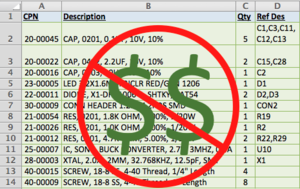
Building a BOM : No Pricing
WHAT SHOULD NOT BE IN THE BOM
In the article, How to make a Bill of Materials, I discussed what should be included in a BOM. But, it’s also important to mention what should not be included.
Under no circumstance should the price of a part be listed during the bill of materials construction. I see this mistake too many times. A released BOM should contain only static data, which will be accurate at any point in the life of the BOM – from the time it was created until the next time an engineer makes a revisioned change. Pricing and lead times are variables. They can change at any moment outside of your control. Therefore, as soon as you list them when creating a BOM, they may become incorrect. So don’t do it!
The price is highly correlated to the packaging option, quantity purchased, and lead time selected. Parts have pricing tiers and expedite options, all with their individual impacts on cost. So, without all of this context, any price you may list in a BOM may not be reflective of the final package, quantity, and lead time chosen for a specific purchase.
Furthermore, when creating a bill of materials, your procurement team may be able to negotiate better pricing and lead times than the listed pricing on your distributor’s website – again proving that price and lead times are variables, and can change independently of the BOM. When people are making critical company decisions based on the information listed in your BOM, it’s crucial to not include anything misleading or prone to change.
Let’s look at a realistic example of how to create a BOM:
For a prototype run, you may purchase enough parts to do a small production of 20 units. Three months later, the BOM has not changed, but now you’re purchasing these same parts for a larger production run of 20,000 units.
Each of these orders would have separate prices and lead times. Which one would you put in your released BOM spreadsheet? The answer is neither. It gets too complicated to list all the pricing permutations without convoluting your BOM. That’s what a PLM (Product Lifecycle Management) tool is for. Keep them separate.
PLM tools have much richer functionality than a static BOM spreadsheet and can handle all of the packaging, pricing, and lead time permutations for your individual components. A good PLM tool will let you select which combination to use to calculate pricing and lead times for a specific production build – without losing context.
Are you using Excel spreadsheets to manage your BOMs, or a professional PLM application? We’d love to hear your thoughts on the topic…